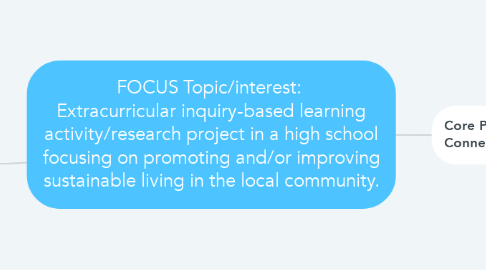
1. 3 interconnect spheres of Connected Learning:
1.1. Peer supported
1.1.1. Inclusivity
1.1.1.1. Students of any year level can participate. Students with additional needs or other minority (EAL/D, ATSI, low socioeconomic) students are invited to participate.
1.1.2. Peer culture based around interest of sustainable living.
1.1.3. Common interest, sustainable living. Result: learners are highly engaged.
1.1.4. Students taught how to effectively peer teach. Experts & other professionals become mediators of specialised knowledge, however, resist extensively giving students easy information.
1.1.5. Meetings & Events: workshops, online forums/discussions (YOUmedia), online and physical meetings & events with novices, peers and expert others (sustainable living scientists, professionals & teachers).
1.2. Interest Driven
1.2.1. Participants are motivated to learn as learning is based on their personal interest.
1.2.2. Learners assume responsibility for their learning (active learning).
1.2.3. Facilitated by networked media: Facebook, Twitter, Google Classroom & Docs, YouTube, Instagram, YOUmedia, Skype and phone calls & texts.
1.2.4. Consistent meetings & tutorials. This is to ensure participants have an on-going personal affinity, passion, and engagement in sustainable living. If not, expert others can guide learners down a different inquiry-learning path to ensure their interest remains high.
1.2.5. Challenging workload for participants. Participants will express through blogs.
1.2.6. Participants choose how they want to present their reports.
1.2.7. Range of Informal activities (e.g. experts and participants walk through community to identify sustainable living alternatives) and formal activities (e.g. creating digital presentation about sustainable living).
1.3. Learner Orientated
1.3.1. Materials and resources: internet, free online tutorials to join social media networks, hardware (computers, iPads, thumb drives etc.) and software (Google Docs, Instagram, Twitter apps).
1.3.2. Teaching/learning skills related to creating digital presentations.
1.3.3. Career advice to pursue vocationally. Attend university open days.
1.3.4. Mentors are facilitators rather than instructors for learners.
1.3.5. Hands-on experiences, research, processing and communicating digitally and in person.
1.3.6. Learning experiences focusing on how students use reflection and metacognition.
1.3.7. Students negotiated learning direction. They select a topic related to sustainable living they want to report on.
2. Core Properties of Connected Learning:
2.1. Shared Purpose:
2.1.1. Learning Goals and Interests: FIGHT FOR THE ENVIRONMENT.
2.1.1.1. Weekly meetings to track individual group’s project development. Can question peers and expert others to improve quality of final digital presentation.
2.1.1.2. Learners who are interest-driven about sustainable living. This extends into the local community.
2.1.1.3. Interested in firsthand research and project development.
2.1.1.4. Opportunity to pursue vocationally.
2.1.1.5. Interested in current technology.
2.1.2. Collaborations and competitions:
2.1.2.1. Contest and competition based on certain criterion related to inquiry learning. Students and professionals create this rubric.
2.2. Openly networked:
2.2.1. Wherever, whenever participants can upload, share and receive information & knowledge, collaborate, provide/receive feedback from peers, experts and community members, receive information about relevant and important events and make visible achievements during this educational journey based on the achievement criterion.
2.2.2. Online media network platforms that will be utilised include Facebook, Twitter, Google Classroom & Docs, YouTube, Instagram, YOUmedia, Skype and phone calls & texts.
2.2.3. Students provided tutorials on how learners can use the online media cognizantly and boundaries of communication, but also when to take advantage of learning opportunities.
2.3. Production-centered:
2.3.1. Digital production tools: I-Movie, Microsoft Office, YouTube, Blogs, iTunes, social media.
2.3.2. Remix and curating practices: Intense periods of receiving feedback and participants being mentored on how to creatively re-create their digital products to support self-expression. They can engage in demos and tutorials.
2.3.2.1. Participants upload progress using pictures, patterns and text
2.3.2.2. Weekly virtual meetings via social media platforms/technology
2.3.2.3. Monthly challenges
2.3.3. Computers, iPhones, iPads, cameras, voice recorders.
